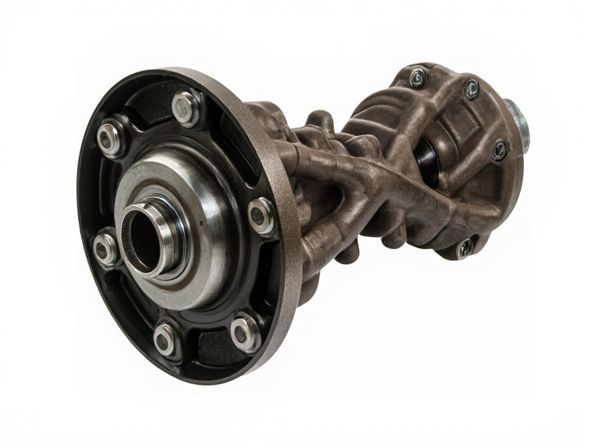
Photo illustration: Cone-Type Limited Slip vs Plate-Type Limited Slip
Cone-type limited slip differentials use friction cones to distribute torque between wheels, providing smooth engagement and better traction under varying road conditions. Plate-type limited slip differentials employ clutch plates to transfer torque more aggressively, offering improved performance during high-power or off-road scenarios. Understanding these differences helps you choose the optimal limited slip differential for your vehicle's driving style and terrain.
Table of Comparison
| Feature | Cone-Type Limited Slip Differential | Plate-Type Limited Slip Differential |
|---|---|---|
| Design | Friction cones engaging tapered surfaces | Multiple friction plates stacked together |
| Torque Transfer | Direct mechanical engagement via cones | Friction from plates generates torque transfer |
| Durability | High durability; wears slower under normal use | Moderate; plates may require replacement over time |
| Maintenance | Low maintenance due to simple design | Requires periodic inspection and plate servicing |
| Weight | Lighter due to fewer components | Heavier because of multiple plates and springs |
| Cost | Generally lower manufacturing cost | Higher cost due to complex assembly |
| Performance | Good for street and mild off-road use | Better suited for high-performance and aggressive driving |
| Heat Dissipation | Less efficient, may overheat under extreme use | Better heat dissipation due to larger contact area |
Introduction to Limited Slip Differentials (LSDs)
Limited Slip Differentials (LSDs) improve traction by distributing torque between wheels, enhancing vehicle stability and performance during cornering or slippery conditions. Cone-type LSDs use conical friction surfaces to engage and provide smooth torque transfer, offering progressive locking and durability under moderate stress. Plate-type LSDs employ multiple friction plates to achieve quicker lock-up and higher torque capacity, making them suitable for high-performance or off-road applications.
Overview of Cone-Type Limited Slip Differentials
Cone-Type Limited Slip Differentials use tapered friction cones to transfer torque between wheels, providing smooth engagement and variable torque distribution. These differentials excel in off-road and performance driving by enhancing traction under low-speed conditions without abrupt lockup. Their design allows for compact size, reliable operation, and efficient power delivery compared to plate-type limited slips.
Overview of Plate-Type Limited Slip Differentials
Plate-Type Limited Slip Differentials utilize clutch plates to distribute torque between wheels, providing superior traction control in variable driving conditions. This design enables smoother engagement and better modulation compared to Cone-Type Limited Slip Differentials, enhancing vehicle stability and cornering performance. Commonly used in performance and off-road vehicles, Plate-Type systems excel in minimizing wheel slip and maximizing power transfer efficiency.
Key Differences Between Cone-Type and Plate-Type LSDs
Cone-type limited slip differentials utilize tapered friction cones to distribute torque, providing smooth engagement and superior heat dissipation during high load conditions. Plate-type LSDs employ multiple clutch plates to transfer torque, offering stronger locking capability and more precise torque control under aggressive driving or racing scenarios. Key differences include engagement feel, with cone-type favoring progressive torque transfer and plate-type allowing for adjustable lock strength and quicker response times.
Performance Comparison: Cone-Type vs Plate-Type
Cone-type limited slip differentials deliver smoother torque transfer with consistent performance under high load, enhancing traction in off-road and performance vehicles. Plate-type limited slip differentials provide quicker engagement and higher torque capacity, making them ideal for aggressive driving and racing applications. Performance comparison highlights cone-types excel in durability and gradual slip control, while plate-types prioritize rapid response and greater holding power.
Applications and Use Cases
Cone-type limited slip differentials excel in high-performance and racing applications due to their smooth torque transfer and quick engagement, making them ideal for sports cars and off-road vehicles requiring precise traction control. Plate-type limited slip differentials are favored in daily driving and moderate off-road conditions for their durability and maintenance ease, commonly found in passenger cars and light trucks. Vehicle manufacturers often select cone-type LSDs for aggressive cornering stability, while plate-type LSDs suit utility vehicles needing reliable traction without the complexity of high-performance settings.
Maintenance and Longevity Considerations
Cone-Type Limited Slip differentials require frequent inspection and timely lubrication to prevent wear caused by the metal-on-metal friction of the cone interface, impacting maintenance schedules. Plate-Type Limited Slip setups tend to offer longer longevity due to their stacked clutch plates that distribute friction more evenly, reducing the likelihood of premature wear under typical driving conditions. Proper maintenance of both types, including fluid changes and component checks, ensures optimal performance and extends service life, but plate-type systems generally demand less frequent intervention.
Cost and Installation Factors
Cone-type limited slip differentials generally offer a lower cost compared to plate-type units due to simpler materials and manufacturing processes. Installation of cone-type limited slips tends to be easier and quicker, often requiring fewer specialized tools and less adjustment, which reduces labor costs. Plate-type limited slips, while typically more expensive, may involve more complex installation procedures and precise calibration to ensure optimal performance.
Pros and Cons of Cone-Type Limited Slip Differentials
Cone-type limited slip differentials offer smoother engagement and better modulation compared to plate-type, which can translate to improved traction during gradual cornering. However, cone-type units are often more sensitive to wear and require more precise maintenance to prevent premature failure, unlike the relatively robust and easier-to-service plate-type designs. The cone mechanism typically delivers a more linear torque transfer but may generate more heat under extreme conditions, limiting its use in high-performance or heavy-duty applications.
Pros and Cons of Plate-Type Limited Slip Differentials
Plate-type limited slip differentials offer enhanced traction control by using multiple friction plates that provide smoother torque transfer and better heat dissipation compared to cone-type designs. They are more durable under high-stress conditions, making them ideal for performance and off-road vehicles, but they tend to be heavier and more complex, potentially increasing maintenance requirements. The increased friction surface area improves grip but can sometimes cause occasional chatter noise or slight driveline binding on sharp turns.
 caratoz.com
caratoz.com